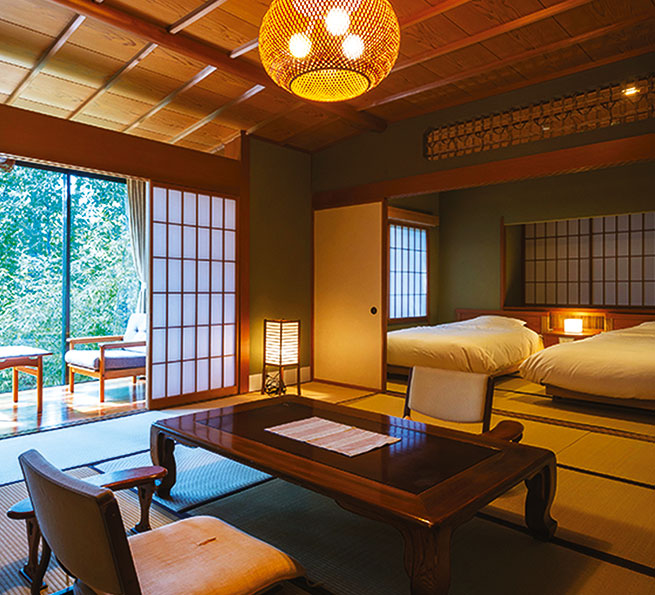
Japan has four distinct seasons, each honoured by a long-standing history of hospitality. In Kaga province in the Ishikawa Prefecture, Keren Lavelle finds the summer perfectly reflected in the cuisine and cultural offerings of its traditional ryokan accommodation.
Halfway along the west coast of Japan’s main island of Honshu lies the town of Kanazawa, for 300 years a bastion of the noble Maeda clan, who ruled here from the late-16th century until the Meiji Restoration in 1868. Their fiefdom, the district known as Kaga, is blessed with mineral-rich soils and reliable rainfall. Despite amassing great wealth from rice production, the Maeda managed to avoid antagonising Japan’s ruling Tokugawa shoguns by avoiding warlike posturing and patronising the arts, inviting artisans and performers to settle in the town, eventually creating a refined artistic culture that still thrives.
Experience the legacy of this culture by shopping for traditional craftware such as kaga yuzen (hand-dyed silk), lacquerware, exuberant Kutani ware pottery and gold-leaf products. Or go hands-on: make traditional sweets, try wood-turning, pottery, gold-leaf embossing or calligraphy. Explore Kanazawa Castle, ancient home of the Maeda lords and stroll through nearby Kenrokuen Garden, once the castle estate; or discover the samurai quarter and the chaya (tea house) districts where geishas still entertain. Visit the bustling 300-year-old Omi-cho food market, dine on exquisite local cuisine and partake of a tea ceremony.
However, the best way to get a taste of Kanazawa’s noble past is to stay at a sumptuous ryokan (traditional inn) in this region renowned for onsen (hot springs). The essence of ryokan lifestyle is to relax – soak in the onsen at the end of the day and then retire to your room where a traditional kaiseki (multi-course) dinner is served in multi-platform lacquerware boxes. Each course is served immediately after it is prepared, to maintain freshness. While you are dining, a maid makes up your futon bed. In the morning, as you breakfast, she packs it away.
Kanazawa is small enough to be easily accessible, and the boutique Ryokan Asadaya (with only five rooms) is at its heart. More than 140 years old (1867), and decorated with antiques, Ryokan Asadaya has been acclaimed as a “traditional cultural asset of Kanazawa hospitality”. When I arrived, I was greeted with a cup of robust tea which, my host explained was more like a soup, restorative and strengthening. At Ryokan Asadaya, guest comfort is taken seriously. Guests complete a questionnaire to ascertain their preferences, right down to pillow choice, and each room is assigned a servant. Yukata (cotton kimonos) are supplied to wear after soaking in the onsen. It is summer, and the ryokan’s menu focuses on fresh fish and vegetables. Green leaves (symbols of summer) decorate most dishes and also appear as motifs on the bowls. Summer flowers adorn the reception area. Lattice has replaced sealed paper screens in walls and doors to allow cooling breezes to circulate.
Several resorts have grown up around Kaga’s onsen. Yamashiro village was created by hotels grouping around a decorative communal bathhouse near the spring’s source. Araya Totoan is best-known. An elegant ryokan with a venerable history, nine of its 18 guest rooms are equipped with private outdoor baths. It was a favourite of artist Kitaoji Rosanjin (1883-1959) also a gourmet, and its cuisine is highly regarded. Totoan also boasts a “secret hideout” bar in an adjacent wooden cottage, originally built for a Meiji imperial visit.
In the small onsen village of Yamanaka, serene Kayotei nestles in a beautiful garden, its 10 suites arranged in the traditional style of a tea ceremony pavilion. This mountain inn maintains close connections to local artisans and producers. “We see ourselves as the inheritors and keepers of the region’s traditions,” says Shuta Takeuchi, youngest member of the family which manages the inn. The family regards the ryokan as a “vessel to showcase the region that surrounds us”. Kayotei serves naturally harvested fish and shellfish, organic rice and vegetables – “ingredients we obtain from our local environment,” says head chef Yutaka Ebihara. Its tatami mats, ceramics and furniture are sourced from local artisans, whose workshops, farms and studios the inn can arrange for guests to visit.
Ryokan etiquette
Plan your arrival for the late afternoon (by 6pm at the latest), which helps the timing for dinner to be served in your room.
Travel light – leave your heavy luggage at another hotel if you can, so your elderly maid doesn’t struggle with a huge bag unable to be rolled on the tatami matting.
Take off your shoes at entry. House slippers or wooden sandals (geta) will be provided, if you want to walk in the garden or outside. Slip off the slippers before walking on the tatami floors of your room.
Before getting into an onsen, soap and scrub your body, wash your hair, and rinse off scrupulously: sitting on a small stool makes this easier.
When you have dried yourself, wear your yukata with the left side over the right side (right over left is reserved for corpses). It is perfectly acceptable to wear yukata outside.
Latest Articles
Don't miss the latest from Luxury Travel
